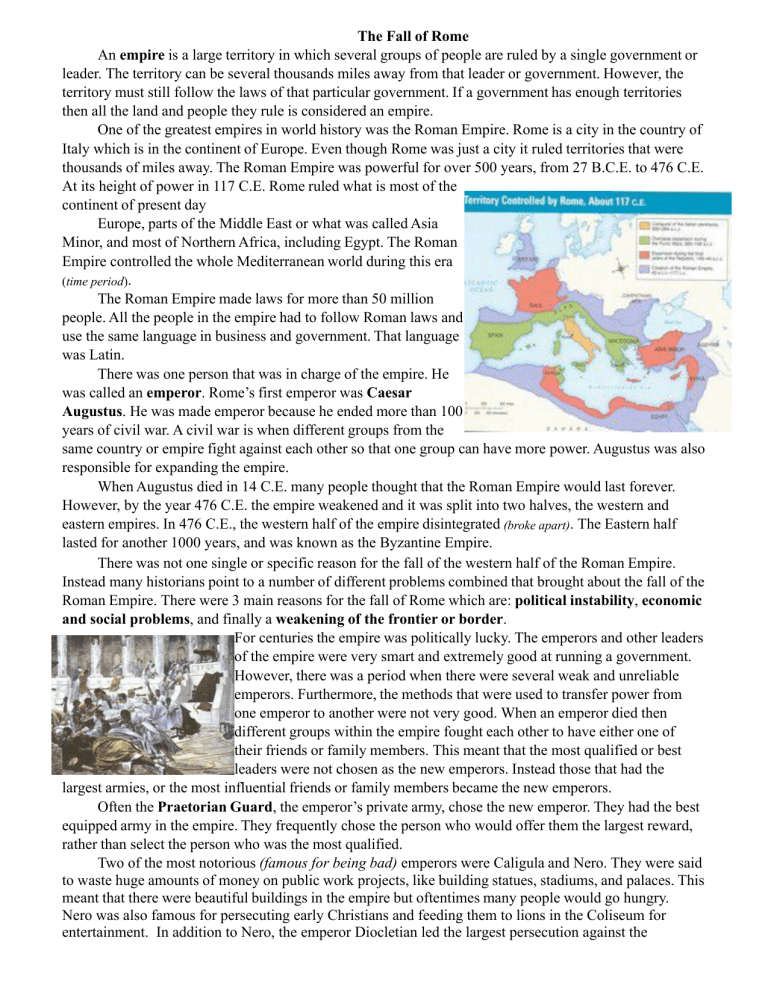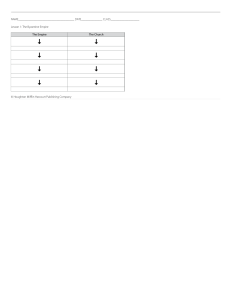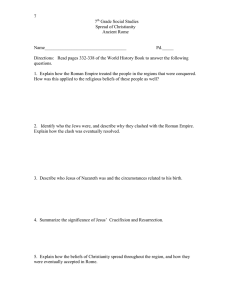
The Fall of Rome An empire is a large territory in which several groups of people are ruled by a single government or leader. The territory can be several thousands miles away from that leader or government. However, the territory must still follow the laws of that particular government. If a government has enough territories then all the land and people they rule is considered an empire. One of the greatest empires in world history was the Roman Empire. Rome is a city in the country of Italy which is in the continent of Europe. Even though Rome was just a city it ruled territories that were thousands of miles away. The Roman Empire was powerful for over 500 years, from 27 B.C.E. to 476 C.E. At its height of power in 117 C.E. Rome ruled what is most of the continent of present day Europe, parts of the Middle East or what was called Asia Minor, and most of Northern Africa, including Egypt. The Roman Empire controlled the whole Mediterranean world during this era (time period). The Roman Empire made laws for more than 50 million people. All the people in the empire had to follow Roman laws and use the same language in business and government. That language was Latin. There was one person that was in charge of the empire. He was called an emperor. Rome’s first emperor was Caesar Augustus. He was made emperor because he ended more than 100 years of civil war. A civil war is when different groups from the same country or empire fight against each other so that one group can have more power. Augustus was also responsible for expanding the empire. When Augustus died in 14 C.E. many people thought that the Roman Empire would last forever. However, by the year 476 C.E. the empire weakened and it was split into two halves, the western and eastern empires. In 476 C.E., the western half of the empire disintegrated (broke apart). The Eastern half lasted for another 1000 years, and was known as the Byzantine Empire. There was not one single or specific reason for the fall of the western half of the Roman Empire. Instead many historians point to a number of different problems combined that brought about the fall of the Roman Empire. There were 3 main reasons for the fall of Rome which are: political instability, economic and social problems, and finally a weakening of the frontier or border. For centuries the empire was politically lucky. The emperors and other leaders of the empire were very smart and extremely good at running a government. However, there was a period when there were several weak and unreliable emperors. Furthermore, the methods that were used to transfer power from one emperor to another were not very good. When an emperor died then different groups within the empire fought each other to have either one of their friends or family members. This meant that the most qualified or best leaders were not chosen as the new emperors. Instead those that had the largest armies, or the most influential friends or family members became the new emperors. Often the Praetorian Guard, the emperor’s private army, chose the new emperor. They had the best equipped army in the empire. They frequently chose the person who would offer them the largest reward, rather than select the person who was the most qualified. Two of the most notorious (famous for being bad) emperors were Caligula and Nero. They were said to waste huge amounts of money on public work projects, like building statues, stadiums, and palaces. This meant that there were beautiful buildings in the empire but oftentimes many people would go hungry. Nero was also famous for persecuting early Christians and feeding them to lions in the Coliseum for entertainment. In addition to Nero, the emperor Diocletian led the largest persecution against the The Fall of Rome Christians in the history of the Roman Empire. Diocletian ruled from 284­305 and was famous for raising the status of Emperor to that of a god­like figure, expanding Rome’s military greatly, and expanding Rome’s tax system to pay for his increase in military and government. He essentially reformed the government and brought temporary stability­ although the stability would not last after his rule. For a period of time many emperors were often assassinated as different groups within the empire tried to gain power. Within a one hundred year period there were 37 different emperors. Out of those 37 emperors, 25 were assassinated (murdered). So many different emperors meant that there was not a strong and stable leader to head the great empire for an extended period of time. Other reasons for the fall of Rome were economic and social problems. In order for Rome to pay for its huge army the empire had to tax all its citizens very heavily. Such high taxes forced may people into poverty. Since there were so many people in poverty, they could not buy as many goods, and trade and the economy suffered. There were also other social problems in the empire at the same time. There was corruption among the leaders of the empire. Often people in positions of power stole from the empire or took bribes to show favoritism to individual people instead of serving all the people of the empire. Such corruption meant that many people were ashamed to be part of the empire. This shame led to a decline in the sense of loyalty that people had towards the empire. For centuries many people were very proud to consider themselves part of the empire. However, the introduction of the social problems of corruption, crime, and unemployment meant that people did not take pride in being a Roman citizen. External problems also led to the fall of the Roman Empire. Another problem that led to fall of the empire was the weakening of the empire’s frontiers or borders. The huge size of the empire made it very difficult to defend. It sometimes took weeks for leaders in Rome to communicate with the generals that were defending the borders. By the 300’s C.E.’s the Non ­ Roman tribes north of the Danube River, known as the Germanic tribes, were invading and stealing food and other goods from the empire. In 330 C.E. the emperor Constantine took a step that changed the future of Roman Empire forever. He moved the capital of the empire from the Italian city of Rome to the city of Byzantium which was 850 miles east and not in danger of invasion from the Germanic tribes. He renamed the city the city New Rome. It was later called Constantinople, after the emperor Constantine. Today that city it is known as Istanbul and is located in the country of Turkey. After Constantine’s reign (time in power) was over, power in the empire was usually divided between 2 different emperors one in the west and one in the east. Rome remained the capital of the western half of the empire and Constantinople was the capital of the eastern empire. The emperors in Rome constantly found themselves threatened by invading Germanic tribes. Finally, in 410 C.E. one of these tribes attacked and looted (stole from) Rome. In 476, the last emperor of Rome was driven from his throne. After the fall of the western half of the Roman Empire, Europe split into several small kingdoms that were ruled by different tribes. In the East the empire continued for another 1000 years. Today we call the eastern empire the Byzantine Empire. However, after Rome fell it did not mean that the greatness of Roman civilization ended. The influence of the Roman Empire lived on through medieval and modern times. There are many institutions and ideas that we have in our society today that were started in the Roman Empire. Things like our modern government, architecture, art, language, law, and philosophy were all started or improved by the Romans. If it was not for the influence of the Roman Empire our modern society as we know it would be very different than it is today. The Fall of Rome 1. What is an empire? 2. What country and continent is the city of Rome located in? 3. Between which 2 dates was Rome a powerful empire? 4. Which three regions did the Roman Empire control at its height of power? 5. What did the Eastern half of the Roman Empire become known as? How long did it last? 6. According to the reading, what were 3 reasons for the fall of the Roman Empire? 7. What are some examples of political instability in the Empire? 8. What are some things that Diocletian is known for? 8. Why were so many different emperors unhealthy for the Empire? 9. Why were the borders of the empire difficult to defend? 10. Who invaded and stole from the Roman Empire? 11. What did the emperor Constantine do that change the future of the Roman Empire? Why did he do this? 12. What is the city of Byzantium known as today? The Fall of Rome 13. When did the western half of the empire end? 14. What 6 things in modern society were influenced by Roman culture? To Complete as a Class: Reasons for the Fall of Rome External Reasons (happening outside of the Empire): Internal Reasons(happening inside of the Empire): Crash Course Video (Fall of the Roman Empire­ Episode 15) Questions: 1) What year was the city of Rome conquered by barbarians in? 2) Who did Rome incorporate into the Roman Army that were not Romans? 3) How did people living in Byzantium identify as? 4) What was the goal of the Council of Nicea in 325? 5) Who is the most famous Byzantine emperor? 6) What famous building did Justinian build that was a church but is now a mosque? 7) Who ruled the church in the Roman Catholic Church in the west? Who ruled the Greek Orthodox church in the east?



